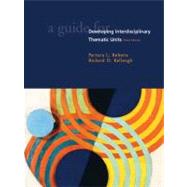
| Introduction to An Interdiscipinary Thematic Unit | |
| Chapter Introduction | |
| Knowledge and Meaningful | |
| Learning Styles of Learning and Implications for Interdisciplinary Thematic | |
| Instruction Integrated | |
| Curriculum and Related Terms | |
| Curriculum Integration | |
| Summary of Purposes Integrated | |
| Curriculum: A Spectrum of Design Role of Theoretical Origins of Instructional | |
| Styles and their Relation to Constructivism and Integrated | |
| Curriculum Role of the Teacher in an Integrated | |
| Curriculum Role of the Students and Input in an Integrated | |
| Curriculum Role of the School for Optimal | |
| Curriculum Integration | |
| Role of Curriculum Standards | |
| Role of Modern Technology and Community | |
| Resources in an Integrated | |
| Curriculum Beginning an Interdisciplinary | |
| Thematic Unit Facts on Praxis and Other Teacher Tests Summary | |
| If a Colleague, Community Member, or Parent | |
| Asks You Abouthellip | |
| Exercises | |
| Chapter Notes | |
| For Further Reading | |
| Initiating an Interdisciplinary Thematic Unit | |
| Chapter Introduction | |
| Selecting a Theme for an Interdisciplinary Thematic Unit Reviewing | |
| Curriculum Standards Standards and High-Stakes Testing | |
| When All Students Are Expected to Do Well on a Mandated Assessment | |
| Then All Should Be Given Equal Opportunity to | |
| Prepare for it Selecting a Theme | |
| A Beginning Process | |
| Giving the ITU a Name Developing a Scope and Sequence for Content and Instruction | |
| Using the Community as a Rich Resource | |
| Sharing Materials Before and During Unit | |
| Implementation Facts on Praxis and Other Teacher Tests Summary | |
| If a Colleague, Community Member, or Parent | |
| Asks You Abouthellip | |
| Exercises Chapter Notes | |
| For Further Reading | |
| Developing Objectives | |
| Chapter Introduction | |
| Clarifying Aims, Goals, and Objectives | |
| Relating Instructional Objectives to Aligned Curriculum and Authentic | |
| Assessment Clarifying Goal | |
| Indicators and Standards-Based Education | |
| Table of Contents provided by Publisher. All Rights Reserved. |
The New copy of this book will include any supplemental materials advertised. Please check the title of the book to determine if it should include any access cards, study guides, lab manuals, CDs, etc.
The Used, Rental and eBook copies of this book are not guaranteed to include any supplemental materials. Typically, only the book itself is included. This is true even if the title states it includes any access cards, study guides, lab manuals, CDs, etc.